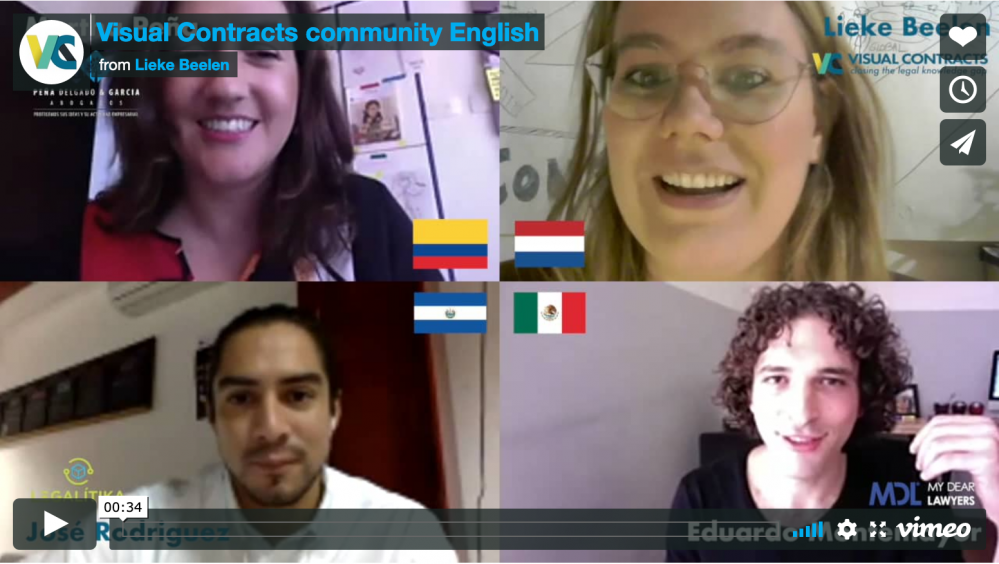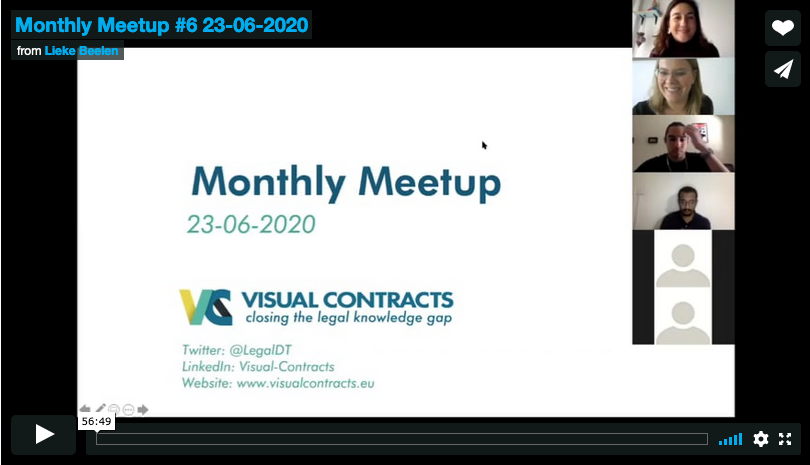LATAM co-creation project
A few weeks ago we started with the 'LATAM co-creation project' in which we are (re)designing a visual employment contract for the LATAM region. The community members that take part in this project are: Martha Peña from Colombia, José Rodriguez from El Salvador, Eduardo Montemayor from Mexico and Visual Contracts' founder Lieke Beelen from the Netherlands. In this blog you can follow the steps we took during the project and what we learned from it.
Outline of the project
Session 1 – Market, existing contracts + user research, start to network to find test participants
- Brainstorm and evaluate on target groups/potential customers
- Share existing employment contract
- Setup user research guidelines/ interview/ questionnaire (depending on chosen target group)
- Find contacts to do user/prototype testing
- Summarize learnings + feedback
- Report/summarize process for blog
Session 2 – Design Vision, criteria, brainstorm/ideation
- Setup design vision together
- Setup criteria
- Make high level content map (intent of the clause + sketch + 1 sentence)
- Brainstorm based on design vision (use existing prototypes/elements as well)
- Summarize learnings + feedback
- Report/summarize process for blog
Session 3 – Prototype + guidelines, test individually
- Create wireframes
- Iterate on clauses (visual + text)
- Create guidelines for testing
- Organise testing + organize test results
- Report test results
- Summarize learnings + feedback
- Report/summarize process for blog
Session 4 – Design finalization
- Detail design
- Create HTML version
- Summarize learnings + feedback
- Report/summarize process for blog
Session 5 – Reflect, sales plan, promotion
- Reflect on process
- Create sales plan
- Create promotion plan
- Finalize blog report
- Summarize learnings + feedback
- Report/summarize process for blog
Session 1 –LATAM Visual contracts Cocreation
During our first meeting, the first question we tried to answer was Who our best first potential client was. At the beginning it appeared to be the government, since, in most of LATAM countries, the public sector is the largest employer for each country. However, soon we realized that the public sector has a rigid contract process, involving fixed annual budgets, administrative and complicated processes and of course, bureaucracy. Not being possible to target the largest employer, we decided to explore the private sector, and in order to do so, we had to have in mind two main issues: (i) companies or private sectors known for being willing to invest in such innovative contracts, for the benefit of their employees or at least for being the first ones in the market to do so, and (ii) the existence of a real need from the employees point of view – due to workers’ education level and the difficulty in understanding long and traditional employment contracts along with a high personnel rotation, which makes the hiring process challenging from the administrative point of view.
Having that in mind, using post-its at MURAL, we displayed some private sectors and each one of us voted for 3 options. The finalists were: call centers, security and cleaning companies, and employment outsourcing companies. The grand price winner was the security companies sector.
Perhaps in other countries such services are the exception, but coming from Colombia, El Salvador and México, for us is daily business and of course it is a large industry.
During the second part of this meeting, we explored some of the obstacles we would face in each country, being the practice of using a formal and written document the main one. For that reason, we understood that perhaps the principal decision we have to make soon is to decide if our prototype shall be an explanation tool, a visual contract per se, or a mix with visual contract plus parts from the traditional one.
Each one of us shared a template of a labor contract of each country, for all of us to find the similarities or differences for the next session.
Session 2 - part 1
During this session we focused on deciding the best way to collect the information. Lieke told us about her experience on obtaining relevant information, and from an interview guide she already had worked with, we made some amendments and decided to use it to conduct the interviews. The idea was to interview not only security guards, as employees, but managers or owners of the security companies. We also had time to share some of our individual projects. Eduardo showed how they are using colors to highlight the main and relevant parts of the contract, José told us about the new changes in El Salvador’s law and his participation in R2P contest, Lieke told us about her experience with a cleaning company and I showed them the downsizing changes made to a data protection document, also with the initial help of colors ,and applying the principles of “Lenguaje Claro”.
For our third session, we will have the answers from our interviews. It will be very interesting to explore the answers and find the similarities, I assume we will have, despite coming from different countries.
Session 2 - part 2 - interviews and design vision
We conducted interviews not only with employees but also with directors of the security companies. We obtained information that was not expected, for instance, (i) the fact that the enrollment process is not an issue, as we assumed, because the security guard companies have plenty of CV's from people willing to work that have already passed the security check, or worked for them before, (ii) the fact that security guards are considered by their employer to be the key element to keep a good relationship with their clients, or (iii) the fact that for security guards it is usual to jump from one job to another, especially if they have good experience or prior references, (iv) the fact that contracts do not include the client as part of the relationship, (v) the fact that, for security guards, interaction with the client is harder than with employer, (vi) the fact that security guards risk their lives and miss acknowledgment for that, and summarizing, that our assumption regarding LATAM security companies was not that close to reality.
With this information, we worked on defining the design vision, which was a hard process for the lawyers of our team, and it was even harder to stick to it afterwards, when designing the actual contract prototype. It was so easy to start dreaming and elaborating, and that way losing track was always a risk that we had to manage on each step.
Session 3
Then we selected the basic structure for the contract, and with that in mind, we worked on the mood board, which was fun and different and helped us realize and confront how different the way of thinking of everyone was. Being an international team, with so different backgrounds, led us to have the most hilarious moments as a team and made us realize how important it is to have an interdisciplinary and mixed group of people, as a way to guarantee that the final products will be as free from biases as possible.
As a result, we got the first structure of the contract, which of course kept changing continuously, but it was very important to have that starting point.
Then came the easy part, at least it was the feeling for the lawyers of the group, as we returned to the words' realm. However, we faced some obstacles when trying to do things as lawyers do, that is, splitting the job. Once again, this creative process showed us the importance of the collaborative work. At the end, and after several changes based not only in our design vision but also in the user experience, we finally had a prototype in our hands, but in English. So, we had to translate it to Spanish to make the testing step possible.
This language issue might seem as a tiny part, but it was not. In fact, the differences between some words in English and Spanish are not limited to their actual meaning, but also to the idea that some of them leave in our minds, or if the concept is too soft or too harsh depending on the context/country, or even if it sounds as mandatory as it should be.
With a prototype in our hands, we discussed about the best way to test it, and we not only defined the guidelines, but a process, since we were in the middle of the quarantine for the pandemic, and for that reason we had to answer all kind of weird questions that in different circumstances wouldn't even exist.
On behalf of the LATAM co-creation team,
Martha Peña


